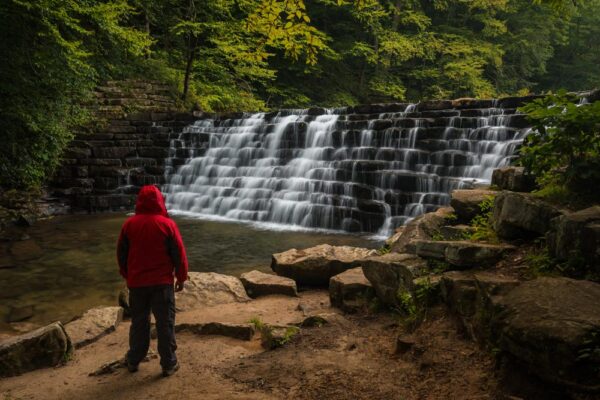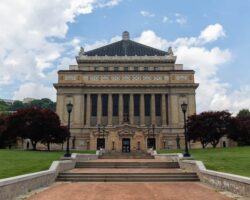Pennsylvania’s state parks are known for their amazing natural beauty. However, many of these parks are also home to amazing historical sites.
From world-changing history to quaint buildings from centuries past, these parks not only offer a beautiful setting, but give us the opportunity to learn about Pennsylvania’s history.
Out of the more than 120 state parks in the state, these are the 10 best historical state parks in Pennsylvania.
See our list of the best Pennsylvania state parks for waterfalls.
Oil Creek State Park

There might be no state park in Pennsylvania that is more historic that Oil Creek State Park. Located in the state’s northwestern corner, this park was where the world’s oil boom first began.
Colonel Edwin Drake struck oil here in 1859 and turned the valley into a boomtown for oil speculators. At one point, just over a century ago, this valley was home to tens of thousands of people.
Today, the park is a testament to nature’s power to reclaim land, though remnants of the oil industry, like abandoned equipment, can be found throughout the park.
In addition to enjoying the biking trails, waterfalls, and fishing in the park, visitors can also take walking tours through ghost towns and learn how the oil industry began in this valley. Another great option is to ride the fantastic Oil Creek and Titusville Railroad through the park, which explores the park’s natural beauty and place in history.
Buchanan’s Birthplace State Park

The first president born in Pennsylvania, James Buchanan, was born on the Pennsylvania frontier near Mercersburg. Today, this piece of land in Franklin County has been designated Buchanan’s Birthplace State Park.
While his place of birth is no longer there, a stone pyramid marks the site where it once stood. Surrounding the marker, signs tell about Buchanan’s life and political career.
Point State Park

Located at the meeting of Pittsburgh’s three rivers, Point State Park is one of Pennsylvania’s most historic state parks.
On this spot, the French and British each built their own forts as control of this important trade route changed hands. Eventually, Fort Pitt was built by the British and would last until the late 1700s.
Today, visitors can not only enjoy the beauty of the city’s waterways and great views of Pittsburgh’s skyline, but can also learn about The Point’s history.
An outline of the fort has been constructed in the park so that visitors can see where Fort Pitt once stood. The park is also home to the Fort Pitt Museum, which tells the story of Pittsburgh’s military history. Next to the museum is the Fort Pitt Blockhouse, the only part of the fort still standing and the oldest building in the city.
Delaware Canal State Park

Delaware Canal State Park is a 60-mile long park that protects the only 19th-century canal that remains completely intact. Following the Delaware River, this canal stretches from Easton in the north to Bristol in the south.
Along the way, visitors can walk, bike, or cross-country ski along the towpath that used to be used by mules pulling canal boats. The canal still features 24 locks and several bridges that add to the historical charm.
While canal boat rides are no longer offered in the state park, visitors can ride a historically-accurate canal boat at the nearby National Canal Museum in Easton.
Kinzua Bridge State Park

Kinzua Bridge State Park in north-central Pennsylvania is home to the remains of the Kinzua Bridge. Built in 1882, it was the longest and tallest railroad bridge in the world when it was completed.
The bridge remained in commercial service until 1959 and was purchased by the state in 1961. Over the years, the bridge became both an attraction for visitors and some even had the chance to ride excursion trains over the bridge.
While being repaired in 2003, a tornado destroyed 60% of the bridge. These ruins were left in the valley, and a new observation area was created out of the remaining portion of the bridge.
Today, visitors can walk out onto the bridge and stare out over this amazing valley from nearly 300 feet above the Kinzua Creek below. A short, but very steep trail leads to the valley floor where visitors can walk amongst the ruins of the bridge.
Note: The walkway at Kinzua Bridge State Park is closed for rehabilitation until late 2027. The visitor center and views of the bridge remain open.
Washington Crossing Historic Park

While Washington Crossing Historic Park has existed since 1917, it has only been a state park since early 2016, making it Pennsylvania’s newest state park. The park is located at the spot where George Washington and his army crossed the Delaware River on Christmas night in 1776. This event is reenacted every Christmas Day.
In addition to preserving this shoreline, the park also maintains 13 historic buildings that would be later built around McConkey’s Ferry. These buildings tell the story of the Delaware River in the years after the Revolution.
A few miles down the road, the park also owns the Thompson-Neely House, which was used as a hospital before and after the crossing. Future president James Monroe recovered here from wounds received in the Battle of Trenton on December 26.
Finally, the park also owns Bowman’s Hill Tower. Sitting atop the hill, this 125-foot tower was built in the 1930s and offers an impressive view over the Delaware River Valley.
Mont Alto State Park

Mont Alto State Park is located in south-central Pennsylvania and is the smallest state park on this list. However, it is packed full of history.
The location of a park run by the Mont Alto Iron Company, the land was acquired by the state of Pennsylvania in 1902. That makes Mont Alto State Park the oldest state park in Pennsylvania (Valley Forge was the first state park in PA, but it is now run by the National Park Service).
In addition to its status as the oldest state park in the system, it also still features a remnant of its days as a company park. One of the two picnic pavilions here was once the carousel house at the turn of the 20th century.
Greenwood Furnace State Park

Located in a rural valley in Huntingdon County, Pennsylvania, Greenwood Furnace State Park is not only historical but also very beautiful. While most visitors come for the scenic lake, the park is also home to several historical structures.
The community of Greenwood Furnace once thrived in this valley, and several remnants of the town still stand. Visitors can explore the iron furnaces which still stand near the park office. While there used to be 20 homes and a handful of shops in the village, there is little left today. Still, the village’s church still holds services in the summer and the blacksmith shop features historic displays and educational programs.
Laurel Hill State Park

Laurel Hill State Park in the Laurel Highlands is home to a beautiful lake and more than 4,000 acres of preserved land. However, what makes it one of the most historic Pennsylvania state parks is its CCC buildings.
The Civilian Conservation Corps was a nationwide initiative during the Great Depression and CCC work can be seen in nearly every Pennsylvania state park that dates back to that era.
The Laurel Hill Recreational Demonstration Area Historic District is part of the National Register of Historic Places. This district contains 202 buildings that were built by the CCC, by far the largest collection of CCC buildings in the state park system.
The park also contains a small strand of old-growth forest that can be seen along the Hemlock Trail.
Little Buffalo State Park

Located in Perry County, Little Buffalo State Park is one of the most historic state parks in Pennsylvania. The land around the park was settled after the Revolutionary War, with the Blue Ball Tavern being one of the first structures in the area.
Eventually, other structures would be built along the shores of the Little Buffalo Creek, including Shoaff’s Mill and Clay’s Covered Bridge.
Today, the historic structures in the park are part of the Little Buffalo Historic District. The covered bridge was moved next to the mill when the lake was created. The mill still features demonstrations throughout the year, especially during the fall.
While Blue Ball Tavern no longer exists, a historic home built on its foundations is now home to the Perry County Historical Society Museum
Ridley Creek State Park

Ridley Creek State Park is located in the Philadelphia suburbs of Delaware County. The park features the gorgeous Hunting Hill Mansion, which now serves as the park office. The mansion was built in 1915 around a stone house from the 18th century.
Adjacent to the home are a beautiful series of gardens unlike anything I’ve ever seen in another state park in Pennsylvania. Take some time to stroll through this beautiful manicured landscape.
In the park’s eastern corner, the Ridley Creek State Park Historic District is home to an 18th century village which features a mill, several workers’ houses, and a dam. The homes here are beautifully maintained as private residences.
The park is also home to the Colonial Pennsylvania Plantation. This living history museum shows visitors what farming and frontier life was like in the region during the late 18th century.
Want even more? Check out our list of the best Pennsylvania state parks for fans of waterfalls.





 "
"




IF YOU LIKE HISTORY YOU SHOULD COME TO WHERE PENNSYLVANIA BEGAN – Essington, PA 19029.
It’s the site of the FIRST PERMANAENT EUROPEAN SETTLEMENT in PA.., BEFORE WILLIAM PENN WAS BORN. The Swedish settlers remained when the Dutch, then English took control of the area. The SWEDES had peaceful relations with the Lenape tribe. William Penn used the Swedes as interpreters and government officials.
Soon the LAZARETTO QUARANTINE STAION, will be restored and open to the public. It was build in 1799, by the City of Philadelphia when it was our new nation’s first capital. in use from 1881 until 1895, protecting the City of Philadelphia from diseases from foreign ports.
It was subsequently used for a pleasure resort by the Philadelphia Athletic Club, then became a school of aviation (sea planes) until WWI when it was used by the Army Signal Corps to train National Guard aviators, (known then as Chandler Field). Tinicum Township purchased the property to save the majestic structure from being raised. The restorations have begun. THIS TRULY is a GEM of our states history.
This was a very enjoyable read. Boiling Springs is a very historic and lovely little town along the border of Adams and York Counties. As the name implies, and as in Lititz, it has a spring that was originally the town’s water supply. The creek running out of the town is a very popular trout fishing area.